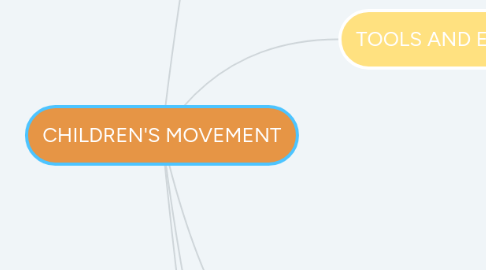
1. PHYSICAL ACTIVITY
1.1. It is important to create opportunities for children to be physically active as it helps to develop their gross and fine motor skills and enhances their health and wellbeing
1.2. Plays a vital role in the development of concentration and thinking skills in young children
1.3. Responding to music with dance is physical movement that helps children demonstrte outcome three of the Eary Years Learning Framework
1.3.1. It is important to provide a range of active and restful experiences throughout the day and support children in making appropriate decisions regarding their participation (age 3-5)
1.4. Fundamental movement skills
1.4.1. Balancing
1.4.2. Rolling
1.4.3. Running
1.4.4. Jumping
1.4.5. Catching
1.4.6. Skipping
1.4.7. Throwing
2. TOOLS AND EQUIPMENT
2.1. Objects that encourage movement-based play (Ages 0-5)
2.1.1. Blocks
2.1.2. Crates
2.1.3. Chairs
2.1.4. Cushions
2.1.5. Loose Parts
2.2. Games that encourage movement (Age 3-5)
2.2.1. Balancing Beams
2.2.2. Hopscotch
2.2.3. Simon Says
2.2.4. Musical Statues
2.3. Baby Bouncers
2.4. Prams
2.5. Play Mats
3. IMPORTANCE OF MOVEMENT
3.1. Freedom of movement is necessary for children to meet their developmental milestones
3.1.1. Walking to and from places within boundaries helps children's physical development. It also helps children in remembering where they live and what there is around them so if they were to ever get lost they could find their way back
3.2. Helps to build strong bones and muscles, achieve and maintain a healthy body weight and reduce injurys
3.3. Improves balance, movement and coordination skills. Promotes mental, emotional, social wellbeing, better learning and thinking
3.4. Babies are active in their own learning and build on the abilities they are born with. They learn best through their movements and thier sensors
3.4.1. It is important to allow children to lead their own movement and play (age 3-5)
4. BENEFITS OF MOVEMENT
4.1. Enhance learner motivation
4.2. Strengthen learning
4.3. Improve memory
5. EDUCATORS ROLE
5.1. Educators need to ensure they support and encourage children to be active. They can do this by giving their children the freedom to create their own play that encourages appropriate risk taking and independence
5.2. It is important that educators give babies and young children the opporutinty to explore the outdoors
5.2.1. This gives children the opportunity to explore the natural environment, have adventures and move their bodies (age 0-5)
5.3. Educators need to intergrate a variaty of gross motor activities to get children moving. They can also work to combine music with movement
5.3.1. Music and dance engages the brain. It allows children to express themselves and become more creative and imaginative (age 3-5)
